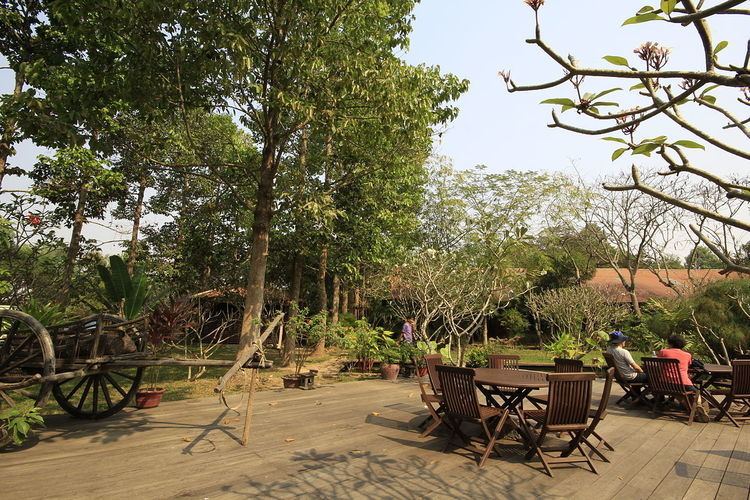Address Puok, Cambodia | ||
 | ||
Hours Closed now Saturday8AM–5PMSunday8AM–5PMMonday8AM–5PMTuesday8AM–5PMWednesday8AM–5PMThursday8AM–5PMFriday8AM–5PM Similar Artisans Angkor, Cambodi Cultural Village, Angkor Wat, Royal Angkor Resort, Angkor National Museum | ||
Artisans d angkor silk farm
Angkor Silk Farm is a site gathering many silk workshops belonging to the Cambodian social enterprise Artisans Angkor. Visitors can discover through free guided tours the complete process of sericulture, from the cultivation of the mulberry bushes to the production of silk goods.
Contents
- Artisans d angkor silk farm
- Official video angkor silk farm
- History
- Silk making process
- The Ikat weaving technique
- References
Angkor Silk Farm is located in Puok District, a 20-minute drive from Siem Reap centre, Cambodia.
Official video angkor silk farm
History
Angkor Silk Farm was created by the National Silk Centre (Centre National de la Soie - CNS) in 1993. Between 1994 and 1996, the National Silk Centre developed and grew bigger.
While the National Silk Centre has focused on training silk farming to young Cambodian from remote rural areas, Artisans Angkor has provided these trainees with employment at the end of their formation. Indeed, there were few opportunities in this sector in the mid-1990s and Artisans Angkor was founded to become a vocational organism for people trained by the National Silk Centre. Therefore, CNS hosts Artisans Angkor at Angkor Silk Farm and both work closely together.
Since its creation, Artisans Angkor has opened 23 silk workshops in Siem Reap province which makes it the largest employer of the region. Besides fulfilling a social mission, the enterprise is renowned as one of the finest silk producers in Cambodia and Angkor Silk Farm has been one of the great attractions of Siem Reap for visitors eager to discover the secrets of handmade silk production.
Silk-making process
Angkor Silk Farm is surrounded by 5 hectares of mulberry trees plantation. These fields are the starting point of the whole process of silk-making as silk worms will eat and grow on them. The trees can grow two meters tall and branches are cut four times a year. Mulberry leaves are silkworms' favourite food and will be eaten for weeks. During the last days, silkworms can eat ten times a day.
When the worms have grown enough, they are put in baskets. From there, they will spin their cocoons in five days and will produce about three hundreds meters of silk each. The cocoons are then put in sunlight to avoid them undergoing their metamorphosis into mature moths. However, 20% of them reach the breeding process and the female moths will lay and hatch its eggs within nine to twelve days.
The cocoons are soaked in hot water in order to soften the sericin (also known as silk gum) which coat the fibres and stick the cocoons together. Silk threads are then unwound and reeled together to produce a single thread. Weavers at Angkor Silk Farm make both raw silk and fine silk that do not have the same texture at all. Sericin has not been completely removed from raw silk threads, which will give a rougher texture to the fabric at the end.
The silk is then dyed by putting natural materials or artificial and environmentally friendly dyes in boiling water. Natural dyes can be created out of bananas, coconut barks, leaves, roots, etc. but fruits and trees don't always have the same hues depending on the seasons which make the use of artificial products necessary to reach the same colour. The dyeing process has to be renewed several times as artisans weave silk fabrics in the old way through the Ikat technique.
The Ikat weaving technique
The Ikat technique (also called "chong kiet" in Khmer) is one of the most ancient weaving techniques in the world and is used to create designs in fabrics. Artisans create a tight knot resistant to dyes which forms an original pattern with the complex intertwining of the warp thread and the weft thread.
One of the most famous and gorgeous kind of silk fabrics in Cambodia is called "Hol Lboeuk" and can only be created with the Ikat technique. Successive tying-in and dyeing process with different colours will yield the fabric geometric or floral motifs.
The threads are then tied-up to a frame. The warp chain will individually pass through dents of the reed to be rolled up again on the cylinder placed in front of the loom. In the meantime, the weaver alternately pedal up and down on the levers to overhang the frame, and to provide the route for the shuttle that carries the weft threads to move from right to left. After each passage of the shuttle, the reed will join and tighten the threads together to make the full fabric. This lengthy and time-consuming process creates the desired pattern.
